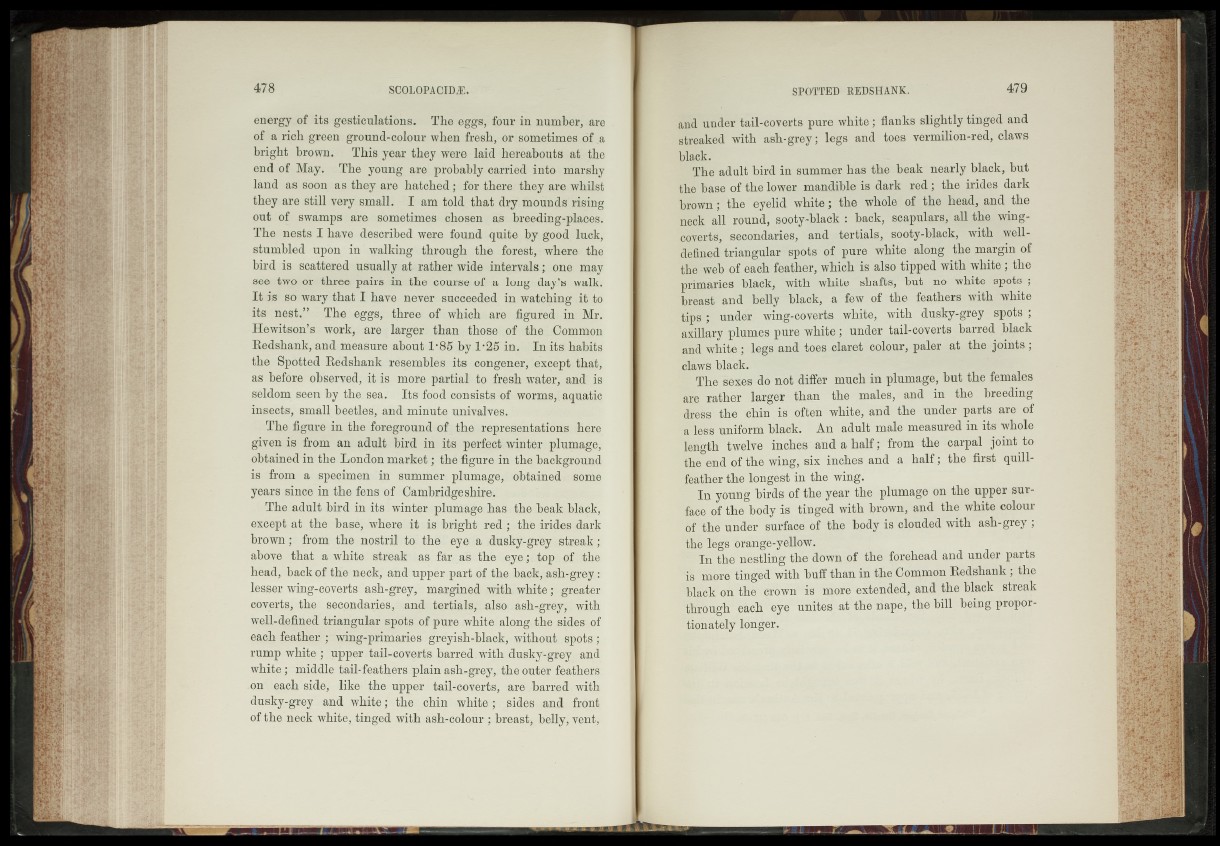
energy .of its gesticulations;.- The eggs, four in number, are
of a rich green , ground-colour when fresh, or sometimes óf .a
bright brown. This year they were laid hereabouts at. the
end of May. The young are probably carried into marshy
land as soon as they are hatched; .for.there they are whilst
they are still very small. I am told that dry mounds rising
out of swamps are sometimes chosen as breeding^places.
The nests I have described were found quite by good luck,
stumbled upon in walking through the forest, where, the
bird is scattered usually at rather wide intervals; one may
see two or three pairs in the course of a long^day.’s walk.
It is so wary that I have never- succeeded in watching dt to
its nest.” The eggs, three Ofjj which are figured in-Mr.
Hewitsoh'S work, are .larger, than those joi ther^Comnion
Redshank, arid measure about l*85 by 1’25 in. In its. habits
the Spotted Redshank resembles its congener, ’except that,
as before observed, it is more partial to fresh water, and is-
seldom seen by the.-sea. • Its food consists of worms,, aquatic
insects, small beetles, and minute univalves,,,!^
. The j&gure in the foreground, ef-j the. representations shore
given is from an adult bird in its perfect, winter plumage,
obtained in the London market; thé figure in theibackground
is from a specimen* Jin' summer, plumage,; obtained*- some
years'since in the fens-of Cambridgeshire.. i
The adult bird in its winter plumage, has. the;heak -black,
except at the base, where i t , isdhfight red.; the,hides'dark
brown ; from the inostriLfo" thè ' eye/Ja .dusky-grey jstreak;
above that a white streak as far as. the3 ioygajiltopt of t,he
head, hack of the ne@k, and upper part of the.hack,^iltegrey:
lesser wing-coverts ash-grey, margined with whit^greatbr
coverts, the secondaries, and tertials, -also .ash-gréy, ‘ with
WglL4p§ned triangular spots of pure .white ’alpng*f he sideSiQf
each feather ; ’wing-priinaries greyish7Black,-'vithouts,@ppts ;
rump white; "upper tail-coverts barred withtjdusky'-grey and
white; middle taibfeathers plain ash-grey, the outèr feathers
onf.each side, like* the upper taiLeoverts, .areJbarred. with
dusky-grey and .white; the chin white, yhjsidés^and -front
ofithe neck white,ytinged with ash,-colqür,.^breast,, belly,' vent,
and under tail-coverts pure white; flanks slightly tinged and
streaked with ash-grey; legs and toes vermilion-red, claws
black.
The adult bird in summer has the beak nearly black, hut
the base of the lower mandible is dark red; the jrides dark
brown; the eyelid white; the whole qfrthe head, and. the
neck all rounds sooty-black : hack, scapulars, all the wing-
eiverts, secondaries, and tertials, sooty-black, with well-
defined triangulars spotsr of pure white along; the margin of
the’welf of each feather, whichris'alSo tipped with white; the
primaries black,, with white shafts, hut no white spots ;
breast and belly "black, a few%nhe feathers with white
tips ;- under wing-coverts white, with dusky-grey' spots ;
axillary 'plunujS pure white.; under tail-covers barred black
and white ; -.legs and tq&s claret colour, paler at, mg joints;
claws black. ' f " " B ^
' The sêxes-rdo not differ much in plumage, but the females
.'are rather larger than a {he males, and in the breeding
"Mess the chin is often white, and the under parts are of
a less uniform black. An adult male measured inits* whole
length ‘twelve inches' and a half; from the carpal joint to
the end of the wing, six inches and a half; the. first quill-1
feather tlfe longest‘in ^ S wing.1 ''
In young birds of the year the -plumage on the upper sur-
[face of -t^é body is tinged with hrojir, and the, white colour
rSP^t’he'under surface of the body is clouded with ash-grey;
thë legs orange-’ydMwi^^^?;^ fj
' i n th:e%eëriiSg-the;dt)wn of the forehead and qqdej parts
f t ; "more tin'^d%ith buff than in the Common Redshank; the
black oÊ^hê^feo^Hs more'extended, and tie black streak
[through e^cÉ^e^e’ unites,-at the nape^HriSisilh being proportio
n afey*lon èer; -